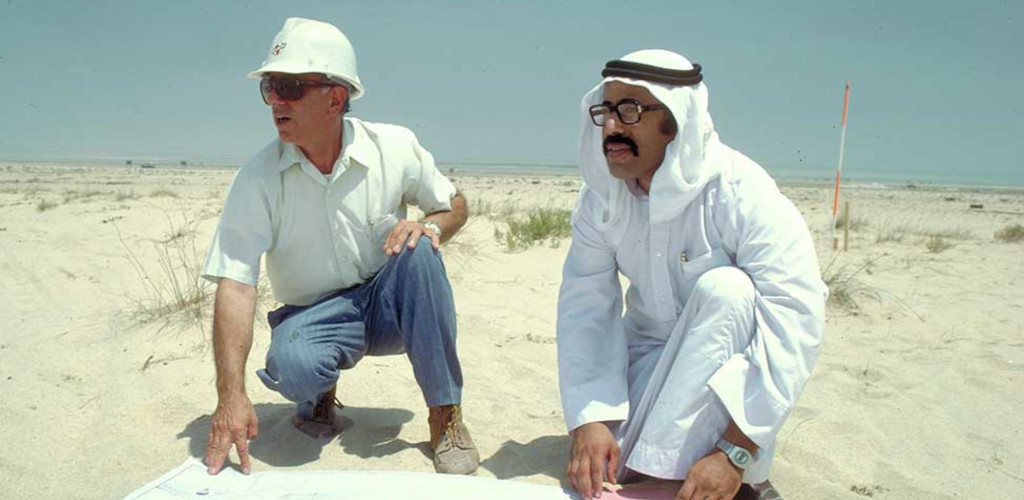John Amos on Supporting the Buildout of the World’s Largest Industrial City

By John Amos
From Issue 1, 2025 of Breakbulk Magazine
(3-minute read)
_1.jpg?width=198&height=220) In 1976, Saudi Arabia undertook one of the most ambitious construction projects in modern history: the development of Jubail, its first industrial city. As a logistics and materials manager, I witnessed firsthand how the Kingdom launched this massive effort to diversify its economy – a strategy many associate with more recent decades. While the working environment was vastly different from my office life in San Francisco, the demands of the project were as fierce – if not fiercer – than those of any multi-billion-dollar project under construction today.
In 1976, Saudi Arabia undertook one of the most ambitious construction projects in modern history: the development of Jubail, its first industrial city. As a logistics and materials manager, I witnessed firsthand how the Kingdom launched this massive effort to diversify its economy – a strategy many associate with more recent decades. While the working environment was vastly different from my office life in San Francisco, the demands of the project were as fierce – if not fiercer – than those of any multi-billion-dollar project under construction today.
Saudi Arabia’s push to diversify its economy began with a clear recognition of its dependence on oil revenue. Leaders realized that reinvesting the wealth generated by their vast petroleum reserves into infrastructure and industrialization was essential to building a sustainable future.
The vision for Jubail exemplified this approach: transforming a modest fishing village on the Arabian Gulf into a fully integrated industrial city. From the outset, the scale of the project was staggering, requiring the expertise of global engineering firms, the cooperation of contractors from dozens of countries, and the development of an unprecedented logistics network.
The Emergence of Middle East Economies
The need for Middle Eastern countries to expand their economies became evident in the late 1960s. Nations like Saudi Arabia developed strategies to invest the proceeds from their vast petroleum reserves into industrializing various manufacturing sectors and producing petroleum products. They also recognized the need to build infrastructure to handle the coming wave of imported construction materials and guest workers.
In addition to individual construction projects, plans were drawn up to design and build industrial cities from the ground up. This required detailed planning and the expertise of global design and engineering firms. These firms also trained young professionals from the region, equipping them to participate in their nations’ development upon returning home.
One of the largest and most ambitious of these projects was Jubail, built along the Arabian Gulf north of Dammam, Saudi Arabia. Construction began in the early 1970s and has continued through various phases of expansion. By 2015, the city included a residential area, seaports for container and multipurpose vessels, an airport, and major industrial facilities producing goods for domestic use and export.
 Approximately 26 major construction companies were involved, and a large training center was established to develop the skills of Saudi professionals. Jubail’s industrial activities are now a significant contributor to Saudi’s GDP.
Approximately 26 major construction companies were involved, and a large training center was established to develop the skills of Saudi professionals. Jubail’s industrial activities are now a significant contributor to Saudi’s GDP.
Keeping construction schedules on time and on budget was a priority then, as it is today. The materials management department played a crucial role, working with contractors from around the world to solve logistics challenges.
Frequent shipments of construction materials meant that any delay in port operations could disrupt progress. Contractors, often unfamiliar with specialized logistics, found that consulting the materials management team helped keep their projects on track.
Customs clearance presented its own challenges. High-value items like computers, electronics and navigation aids were subject to strict government controls, requiring meticulous compliance to avoid delays. Letters of credit frequently governed the movement of these goods, with banks retaining bills of lading until payment was confirmed.
Planning for the Unpredictable
Before bidding on projects like Jubail, potential financial risks had to be studied thoroughly. Countries’ laws varied widely and were strictly enforced. Contracts addressed issues such as liability for delays, civil unrest and cancellations. Master agreements specified where disputes would be adjudicated, ensuring that all subcontractors understood their responsibilities.
The influx of foreign professionals and construction workers brought economic and cultural transformation to Jubail. Shops and businesses opened to cater to the growing population, enhancing quality of life for locals and expatriates alike. These workers, in turn, spent their earnings locally, creating jobs and further stimulating the economy.
The industrial city of Jubail stands as a testament to vision, planning and global collaboration. It has transformed the region economically and socially while fostering greater understanding among the people who built it. For those of us who were part of its early days, the experience was as much about the challenges we overcame as the lessons we learned.
Jubail by the Numbers
50: Average annual number of Bechtel’s construction projects in Jubail (Project Management Institute)
7%: Percentage of Saudia Arabia’s total GDP contributed by Jubail (Bechtel)
1,016 km2: Area of Jubail Industrial City, making it one of the largest industrial cities in the world (Bechtel)
100 km: Railway tracks as part of the city’s infrastructure (railknowledgebank.com)
70%: Percentage of Saudi Arabia’s non-petroleum exports produced at Jubail (The Energy Year)
Over 80%: Percentage of Jubail’s employees within the city’s primary industries are Saudi nationals, and most are employed in highly skilled jobs (The Energy Year)
9 million tonnes: Amount of carbon captured and stored in what will be the world’s largest CCUS project under construction in Jubail; scheduled to be completed by 2027 (The Energy Year)
US$3.8 billion: Cost of Jubail II, initiated in 2006, to expand industrial and residential areas (Bechtel)
120,000: Number of new accommodations for residents in Jubail II, along with a greenfield university for 18,000 students (Bechtel)
40: The number of years Bechtel has been managing the Jubail projects (Bechtel)
John Amos is a former global head of logistics and procurement for Bechtel.
Check out previous stories in our Breakbulk Throwback series:
Disaster Averted During Refinery Move: A Near-Calamitous Situation in Canada
The CEC Future Hijacking: Murray Cooper on Minimizing the Impact of a Crisis
Memories of Rebuilding Iraq: How Tea and Talk With Tribal Leaders Led to Project Success
Pizza, Burgers and Christmas Trees! Offbeat Shipments Required for Algerian LNG Project
TOP PHOTO: Bechtel surveyors working in the Jubail area in 1977. CREDIT: Bechtel
SECOND: Pipe and spool installation at the Jubail site. CREDIT: John Amos, Jubail Reunion Materials
